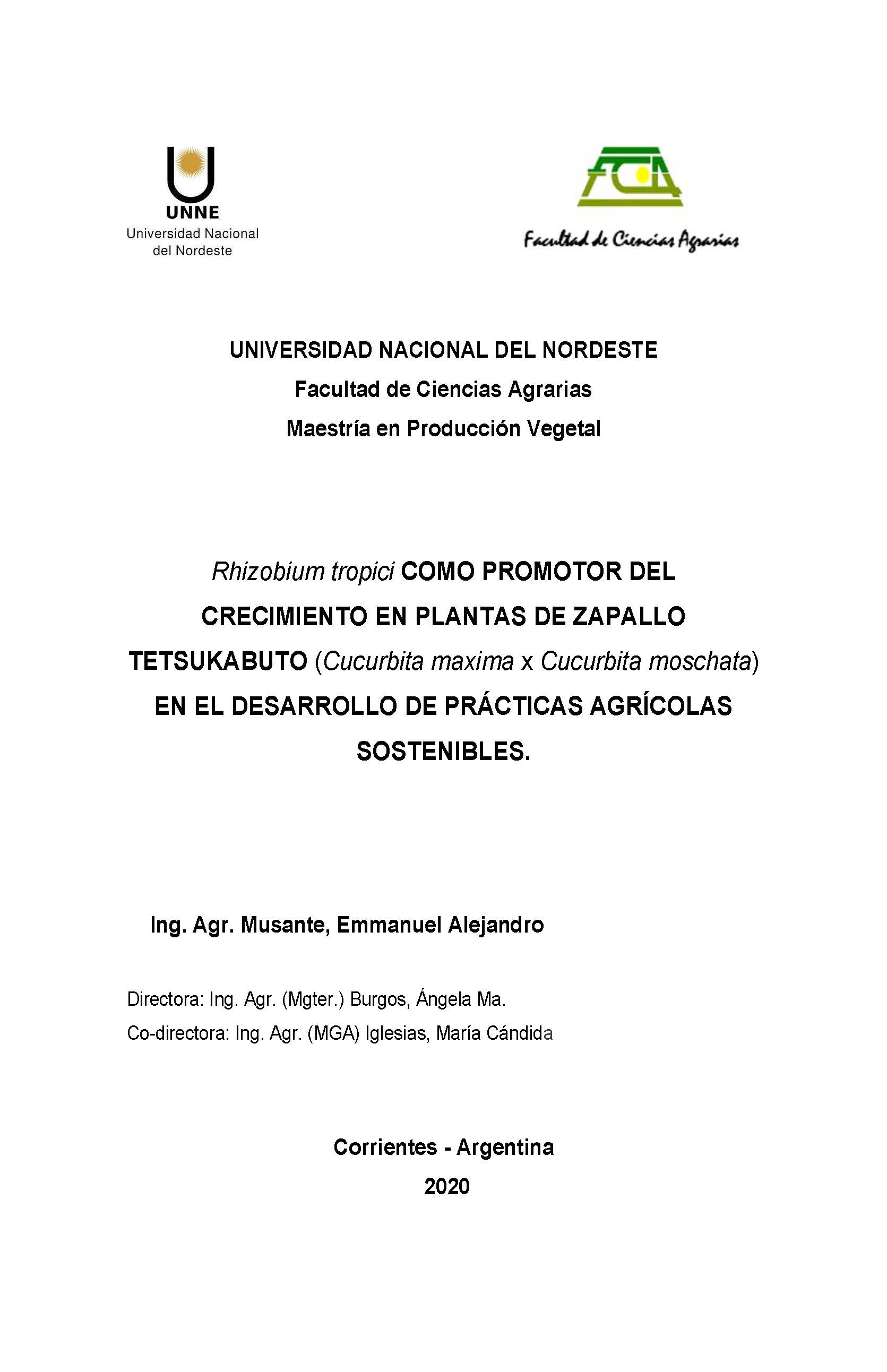Ver ítem
- xmlui.general.dspace_homeCentros Regionales y EEAsCentro Regional CorrientesEEA CorrientesTesisxmlui.ArtifactBrowser.ItemViewer.trail
Rhizobium tropici como promotor del crecimiento en plantas de zapallo tetsukabuto (Cucurbita maxima x Cucurbita moschata) en el desarrollo de prácticas agrícolas sostenibles
Resumen
Motivados por los bajos rendimientos locales del zapallo Tetsukabuto (Cucurbita maxima x Cucurbita moschata) y en la búsqueda de un sistema productivo sustentable que los revierta, surgió el objetivo de evaluar la respuesta del mismo inoculando las semillas con el PGPR (rizobaceterias promotoras del crecimiento vegetal) Rhizobium tropici. El experimento se realizó en un suelo arenoso del noroeste de la Provincia de Corrientes durante dos campañas
[ver mas...]
Motivados por los bajos rendimientos locales del zapallo Tetsukabuto (Cucurbita maxima x Cucurbita moschata) y en la búsqueda de un sistema productivo sustentable que los revierta, surgió el objetivo de evaluar la respuesta del mismo inoculando las semillas con el PGPR (rizobaceterias promotoras del crecimiento vegetal) Rhizobium tropici. El experimento se realizó en un suelo arenoso del noroeste de la Provincia de Corrientes durante dos campañas consecutivas de los años 2014 y 2015. Las variables evaluadas en condiciones de experimentación semi-controladas fueron: Volumen de Raíces (VR), Biomasa Seca de Raíces (BSR), Biomasa Seca de Parte aérea (BSPA), Área foliar (AF) y colonización de raíces. Las variables evaluadas en los experimentos en condiciones de producción reales fueron asociadas a la economía del Carbono: Biomasa Fresca Hoja (BFH), Biomasa Seca Hoja (BSH), Biomasa Fresca Tallo (BFT), Biomasa Seca Tallo (BST), Biomasa Fresca Total (BFTotal), Biomasa Seca Total (BSTotal), Biomasa Fresca de Fruto (BFF), Biomasa Seca de Fruto (BSF), Índice de Cosecha (IC), Número de Frutos Por Planta (NFPP), Diámetro Ecuatorial de Fruto (DEF), Espesor de Pulpa de Frutos (EPF) y Área Foliar (AF). El presente constituye el primer trabajo en el cual se evaluó Rhizobium tropici como PGPR en zapallo Tetsukabuto y se determinó que en condiciones semi-controladas, su aplicación no incrementa significativamente el crecimiento de las plantas durante el plazo acotado de evaluación de 30 días después de la siembra (DDS). En las condiciones de campo, si bien Rhizobium tropici fue capaz de promover una mayor AF, no se incrementó la biomasa seca total, pero pudo aumentar el peso y tamaño individual de los frutos, en detrimento de su número. Otro objetivo del trabajo fue establecer una escala fenológica del zapallo Tetsukabuto que respondió adecuadamente al modelo basado en el tiempo térmico a partir de una Temperatura base (Tb) de 10°C.
[Cerrar]
Motivated by the low local yields of the Tetsukabuto squash (Cucurbita maximum x Cucurbita moschata) and in the search for a sustainable productive product that increases it, arose the objective of evaluating the response of Tetsukabuto squash by inoculating it seeds with the PGPR Rhizobium tropici. The experiment toke place on a sandy soil from northeast of Corrientes province during two consecutive campaigns of year 2014 and 2015. The variables
[ver mas...]
Motivated by the low local yields of the Tetsukabuto squash (Cucurbita maximum x Cucurbita moschata) and in the search for a sustainable productive product that increases it, arose the objective of evaluating the response of Tetsukabuto squash by inoculating it seeds with the PGPR Rhizobium tropici. The experiment toke place on a sandy soil from northeast of Corrientes province during two consecutive campaigns of year 2014 and 2015. The variables evaluated in the experimental conditions were: Root Volume (VR), Root Dry Biomass (RDB), Seedling Dry Biomass (DAB), leaf area (LA) and root colonization. The variables evaluated in the experiments under the conditions of real production were associated with carbon economy: Leaf Fresh Biomass (FBL), Dry Leaf Biomass (DLB), Stem Fresh Biomass (SFB), Stem Dry Biomass (SDB), Total Fresh Biomass (TotalFB), Total Dry Biomass (TotalDB), Fresh Fruit Biomass (FFB), Dry Fruit Biomass (DFB) Number of Fruits per Plant (NFPP), Equatorial Fruit Diameter (EDF), Fruit Pulp Thickness (FPT) and Foliar Area (FA). This report is the first work in which Rhizobium tropici was evaluated as PGPR in Tetsukabuto squash, and it was determined that under semi-controlled conditions, its application does not significantly increase the growth of the plants during the evaluation period of the 30-days after sowing (DAS). Under field conditions, although Rhizobium tropici was able to promote greater foliar area, the total dry biomass has not increased, but the weight and the individual size of the fruits has, at the expenses of its number. Another objective of the work was to establish a phenological scale of the Tetsukabuto squash that responded appropriately to the model based on thermal time set aside from an ambient temperature of 10 ° C.
[Cerrar]

Director de Tesis
Burgos, Ángela María (directora);
Iglesias, María Cándida (co-directora);
Descripción
Tesis para obtener el grado de Magister Scientiae en Producción Vegetal, de la Universidad Nacional del Nordeste, en 2020
Fecha
2020
Editorial
Facultad de Ciencias Agrarias, Universidad Nacional del Nordeste
Formato
pdf
Tipo de documento
tesis de maestría
Palabras Claves
Derechos de acceso
Abierto
 Excepto donde se diga explicitamente, este item se publica bajo la siguiente descripción: Creative Commons Attribution-NonCommercial-ShareAlike 2.5 Unported (CC BY-NC-SA 2.5)
Excepto donde se diga explicitamente, este item se publica bajo la siguiente descripción: Creative Commons Attribution-NonCommercial-ShareAlike 2.5 Unported (CC BY-NC-SA 2.5)


